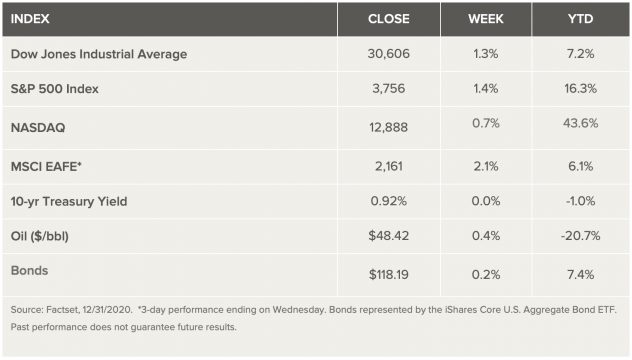

Stock Markets
The holiday shortened trading week saw the S&P set a fresh record high on Monday as another round of unemployment benefits and stimulus checks were announced. The market has increasingly focused on the size and magnitude of the stimulus bill as well as the rising coronavirus case count and initial stages of the vaccine rollout. Even as the vaccine is rolled out, England has extended its toughest coronavirus restrictions to three quarters of the population. This week also saw the signing of a long-awaited Brexit deal between the U.K. and the E.U. On the economic front, the Bureau of Labor and Statistics released initial jobless claims that were sizably below consensus estimates and the prior period. Although positive, the levels are still firmly elevated from pre-pandemic levels and point to a job market that is still under stress. As we enter the new year, analysts expect GDP growth to slow in Q1, but eventually recovering. They also expect bouts of volatility in the equity market as investors balance rising case counts and continued vaccinations, however, they say that markets will be supported by historic monetary and fiscal support and has a positive long-term outlook.
US Economy
Stocks finished 2020 with a gain of more than 15%, a welcome figure but one that doesn’t begin to tell the story of the market’s path to get there. Nevertheless, this was fifth year in the past decade in which the S&P 500 posted a return of more than 15%, doing so in a year that contained a global pandemic, record-breaking recession and a contentious presidential election. This highlights;
1. the importance of staying calm when the markets seem to be panicking,
2. the value of a disciplined investment strategy and diversified portfolio, and
3. the forward-looking nature of the stock market.
Analysts anticipate tepid expansion in the early portion of the year, stunted by lingering measures to slow the spread of COVID-19. Growth should accelerate as the vaccine becomes widely available, allowing consumer, work, leisure and travel habits to return toward more sustainable levels. They widely agree that 2021 will begin a multi-year economic expansion, with widespread distribution of the vaccine sparking progress toward a new normal for the U.S. economy. Meanwhile, the one-two punch of monetary and fiscal policy stimulus will keep a tailwind at the economy’s back.
Metals and Mining
Gold and silver prices entered the final week of 2020 edging higher, with both metals receiving support from US President Donald Trump’s signing of a coronavirus relief bill. Trump had initially refused to okay the bill, saying that the US$600 allocated for citizens needed to be topped up to US$2,000; although the bill wasn’t adjusted, he signed it into law on Sunday. Conversations have continued around increasing the payments to US$2,000, and prices for gold and silver have stayed elevated. Gold was trading just under US$1,900 per ounce at the end of the day on Thursday, while silver was at about US$26.40 per ounce. Both metals have had stellar performances in 2020, with gold adding about 21 percent to its value-year-to-date and silver seeing a price increase of around 45 percent over the course of the year. The precious metals did see drops in March, when global markets reacted swiftly and negatively to COVID-19 restrictions. Gold and silver sunk to US$1,498 and US$11.94, respectively, at that time. A strong rebound off investor sentiment pushed gold to a record high by August, and for its part silver rallied to a seven-year high.
Looking back on 2020, FocusEconomics economist Steven Burke explained that the precious metal’s price growth was closely tied to the global reaction to COVID-19. “The pandemic invoked unprecedented economic uncertainty, which led to a surge in safe-haven demand and, in turn, boosted gold prices,” Burke told the media. He anticipates that prices for the yellow metal will be rangebound into 2021. Aside from the health crisis, there are US fiscal measures like stimulus that will work as tailwinds for a higher gold price, he explained. “A (Joe) Biden administration is expected to bring about stronger public spending, which is projected to boost US domestic demand and economic growth — more than was anticipated under a Trump second term,” said Burke.
As for silver, the white metal was unable to break its previous 2011 price high of US$47.94 but was still able to outperform gold. The dual metal rose as much as 147 percent from its March low of US$11.94 to its August high of US$29.85. In fact, demand for silver exchange-traded products drove global holdings to more than a billion ounces for the first time. Physical silver investment climbed 27 percent in 2020 to a five year high as well.
Energy and Oil
Oil has seesawed back and forth over the past week, sandwiched between very strong bullish and bearish forces on each side. Covid-19 is at its worst in many parts of the world, but vaccinations are picking up in earnest as well. Brent edged back above $51 per barrel after the house passed a major stimulus bill on Monday evening. “Markets feel very rangy into the New Year but should find support today from broader risk markets as stocks are soaring on the prospects of larger stimulus checks,” said Stephen Innes, chief global market strategist at Axi. The terms of a new OPEC+ production pact could be revised if oil demand recovers next year faster than currently expected, Russian Deputy Prime Minister Alexander Novak, who is still in charge of coordinating Russia’s oil policy with OPEC, told Rossiya TV news channel in an interview on Monday. Rising JKM prices for LNG in Asia brighten the outlook for U.S. LNG exports. “We assume near-max utilization rates of US LNG export facilities next year,” Bank of America said. Meanwhile, oil and gas companies in North America and Europe wrote down around $145 billion in assets in the first three quarters of 2020, the most since 2010. Prices are rebounding, but the write-downs also reflect long-term concerns. “They are coming to grips with the fact that demand for the product will decline, and the write-downs are a harbinger of that,” KPMG’s Regina Mayor told the WSJ. Natural gas spot prices rose at most locations this week. The Henry Hub spot price rose from $2.45 per million British thermal units (MMBtu) last week to $2.67/MMBtu this week. At the New York Mercantile Exchange (Nymex), the price of the January 2021 contract increased 24¢, from $2.442/MMBtu last week to $2.677/MMBtu this week. The price of the 12-month strip averaging January 2021 through December 2021 futures contracts climbed 20¢/MMBtu to $2.780/MMBtu.
World Markets
Shares in Europe rose, lifted by the UK-European Union (EU) trade accord and the approval of a U.S. fiscal stimulus package. The UK’s FTSE 100 Index recorded modest losses, partly due to the stronger British pound, which reached USD 1.3675, its highest level in a year. UK stocks tend to fall when the pound rises because many companies that are part of the index are multinationals with overseas revenues. Most European markets closed early due to the New Year’s Day holiday.
Finland’s Central Bank Governor Olli Rehn said that the European Central Bank was monitoring the euro exchange rate very closely. The euro climbed to its highest level in 2020, to around USD 1.2300, partly due to underlying weakness in the greenback and the post-Brexit trade deal.
The UK government extended its strictest restrictions to additional areas, seeking to curb a surge in infections, hospitalizations, and deaths caused, in large part, by a new variant of the coronavirus. Three-quarters of the country is now in a de facto lockdown. After regulatory approval, the authorities began deploying a second vaccine, one produced by AstraZeneca and Oxford University, enabling the government to accelerate its inoculation program. EU countries began to distribute the Pfizer/BioNTech vaccine to those most at risk. The EU also exercised its option to buy another 100 million doses of the vaccine.
Chinese stocks finished a holiday-shortened week at multiyear highs as investors anticipated stronger growth in 2021. The country’s benchmark SSEC Index rallied Friday to its highest close since February 5, 2018, while the blue chip CSI300 Index recorded its highest close since June 15, 2015, according to Reuters. For the year, the SSEC Index advanced 14% and the CSI300 Index rallied 27%, buoyed by signs of an accelerating economy as China became the first major world economy to successfully contain the coronavirus.
In a week devoid of major economic releases, Ant Group stayed in the spotlight as the Chinese financial technology giant remained the target of a growing regulatory crackdown. The People’s Bank of China (PBOC) is considering plans to force Ant Group to shed equity investments in some financial companies, a move that would curb its influence over the sector, Bloomberg reported Thursday, citing unnamed individuals. Over the previous weekend, the PBOC summoned Ant executives and told them to “rectify” violations in the company’s lending, insurance, and wealth management businesses, though the central bank stopped short of calling for a widely feared breakup of the company.
The Week Ahead
The upcoming week will see the PMI composite, Unemployment Rate, and Factory Orders data being released.
Key Topics to Watch
- Markit manufacturing PMI
- Construction spending
- ISM manufacturing index
- Varies Motor vehicle sales
- ADP employment report
- Markit services PMI
- Factory orders Nov.
- FOMC meeting minutes
- Initial jobless claims (regular state program, SA)
- Initial jobless claims (federal & state, NSA)
- Continuing jobless claims (regular state program, SA)
- Continuing jobless claims (federal & state, NSA)
- Trade deficit
- ISM services index
- Nonfarm payrolls
- Unemployment rate
- Average hourly earnings
- Wholesale inventories
- Consumer credit
Market Summary
